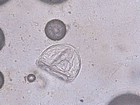Difference between revisions of "Anoplocephala"
| Line 26: | Line 26: | ||
[[Category:Anoplocephalidae]] | [[Category:Anoplocephalidae]] | ||
[[Category:To_Do_-_Max]] | [[Category:To_Do_-_Max]] | ||
| + | [[Category:To_Do_-_Review]] | ||
Revision as of 08:33, 15 July 2010
| This article is still under construction. |
Introduction
Anoplocephala is from the family Anoplocephalidae. Several species of Anoplocephala occur in equidae, but A. perfoliata is the only common species in the UK. It is an equine cestode, more commonly known as a tapeworm. It is currently commonly seen in horses within the UK, usually affecting younger horses.
Identification
Superficially, A. perfoliata looks more like a trematode than a tapeworm, but closer inspection reveals that the body compromises many segments that are wide, but very short. These parasites have no hooks, but do have large suckers that allow the parasite to attach to the mucosal surface. An adult may be 4-8cm in length. The gravid segment contains characteristic eggs with a ‘rounded triangular’ shape, which are around 70μm long. The oncosphere is contained in the ‘pyriform apparatus’ (a chitinous ring with two projections).
Life-Cycle
Each worm has male and female segments, which reproduce via hemaphroditism. The male segment fertilises the female segment. The reproductive organs then deteriorate, leaving only a uterus full of eggs. This then detaches from the rest of the worm and migrates to the large intestine, where it ruptures releasing the eggs.
The eggs released are infective to oribatid mites, which act as the intermediate host. These mites live in the ground, feeding on plant debris. These are ubiquitous, but most numerous on permanent pasture in the summer months.
The mites ingest the egg. Cysticercoid larvae hatch, and live within the mite for its entire life. These cysticercoid become infective around two weeks after hatching.
The horse, which acts as the definitive host , ingests the mites in spring, when grazing the pasture.
They attach to the mucosa, and transform into adults in around 6- 10 weeks. The adults live in the ileum, at the ileocaecocolic valve, and within the caecum. The adults are capable of shedding large numbers of eggs.
The adults live for 4-6 months, and disease is most commonly seen between October and November.
The prepatent period is 6-10 weeks.
